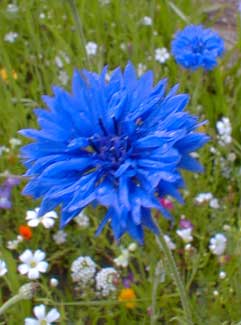
Old-fashioned Bachelor Buttons;
or, Blue Cornflowers
Blue Bachelor Buttons is one of the most commonly gardened annuals, its popularity insured by its extreme beauty & its equally extreme ease of growing. It is so startlingly blue that many secondary common names allude to it: Bluebottle, Bluebow, Bluebonnet, Bluecap, Blue Buttons, Bluet, Blue Star Thistle, or Cyani. It is a "bonnet," "cap" or "bottle" because of the unusual shape of the flower, which can be appreciated in the second, side-on photo. The most used name Bachelor Buttons refers to an old type of collar-button or cufflink that had just this shape.
It can be started from seeds strewn directly on the surface of the ground (or on a scraped surface), to be done at the end of winter or early spring. In warmer zones it can be done in autumn. When sewn in spring, they will be in full bloom by June, with just a little watering (in our zone, rainfall is usually sufficient). If not deadheaded, or taken rigorously as cut flowers, it is apt to reseed wherever winters are mild enough, but is not considered aggressive.
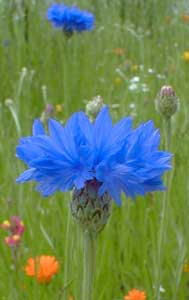 They don't do well in shade or substory locations, but are otherwise so sure & trouble-free that they are recommendable for a child's first garden. They can also be sewn into fields & open spaces as wildflowers.
They don't do well in shade or substory locations, but are otherwise so sure & trouble-free that they are recommendable for a child's first garden. They can also be sewn into fields & open spaces as wildflowers.The alternate name Cornflower derives from their habit of naturalizing within & on the fringes of cornfields. During the Napoleonic wars, when Queen Louisa of Prussia was forced out of Berlin, she hid with her children in a field of grain. To keep her children still while war waged all around, she sat with her children in the corn, weaving wreaths out of the bachelor-buttons. This is why her son Wilhelm, when he became Emperor of Germany, made the bachelor-button the emblem of his rule.
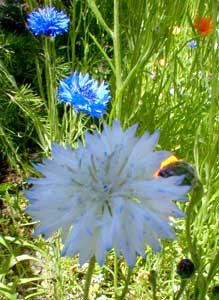 There is such mythic power to the story of the motherly boldness of Queen Louisa that it seems hardly possible it actually happened, rather than being a tale retold since an ancient time when the blue flowers signified the presence of the Mother Goddess. It is also the national flower of Estonia, where from time immemorial it has been associated with wealth, because its luminous flowers grew best in the richest fields of grain.
There is such mythic power to the story of the motherly boldness of Queen Louisa that it seems hardly possible it actually happened, rather than being a tale retold since an ancient time when the blue flowers signified the presence of the Mother Goddess. It is also the national flower of Estonia, where from time immemorial it has been associated with wealth, because its luminous flowers grew best in the richest fields of grain.Many tales are told of youths turned into flowers, the most famous being Narcissus. Such tales recall an ancient time when the Mother Goddess had a youth as companion, either a son or a lover, instead of a husband, because the Mother Goddess was supreme in herself. Such companions were fertility daemons who assisted in the fertility of the Goddess, of humanity, & of the whole natural world. A Russian fairytale recalls these old religious norms but reshaped in a medieval guise:
A water-nymph or villa named Rusalka left her river to wander in the fields, as she was prone to doing, always returning to the water before her hair was entirely dry. She was a Spirit of Vegetation, or a bohynia, "goddess." It was She that brought moisture to crops. During the whole of the second week of June, the peasants danced in honor of Rusalka, to encourage her to bring moisture & fertility to the forests & fields. They gave her prayers of thanks for the world's fresh verdance. It was the peoples' songs & dances that drew her from the waters, & she was a greatly beloved spirit, invoked not only for the sake of fields, but also at every wedding.
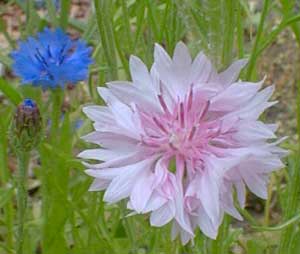 Still, she was simultaneously feared, continuously placated with offerings of linen left for her on river banks, for she had the power of an ancient & severe Goddess within her. As easily as she bestowed fertility & life, she could as easily, carelessly & despite a well-meaning temperament, bring about mortal destruction. At times she seemed as though she were only the lonely ghost of a drowned virgin, whose embrace was the embrace of eternal sleep.
Still, she was simultaneously feared, continuously placated with offerings of linen left for her on river banks, for she had the power of an ancient & severe Goddess within her. As easily as she bestowed fertility & life, she could as easily, carelessly & despite a well-meaning temperament, bring about mortal destruction. At times she seemed as though she were only the lonely ghost of a drowned virgin, whose embrace was the embrace of eternal sleep.She spied the youth Basilek upon a road & was instantly smitten. He in turn saw the beautiful Rusalka whose damp hair hung loose about her. The vision of her caused Basilek to forget all the warnings against pursuing her aquatic race. He ran into the cornfield after the sound of her musical laughter, & she let herself be captured. They fell together rolling & playing & laughing, & she began tickling him relentlessly, until he could no longer breathe, & so died of the seduction. Sorry for what she had done, Rusalka turned Basilek into the first of all bachelor buttons, still called Basilek in Slavic countries today.
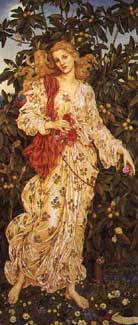 This Slavic & Russian fairy tale recalls the older myth of the youth Kyanos, who was loved by the Goddess Flora of Rome, for whom the May Floralia was held annually.
This Slavic & Russian fairy tale recalls the older myth of the youth Kyanos, who was loved by the Goddess Flora of Rome, for whom the May Floralia was held annually.Flora (in Greek, Chloris, the one surviving daughter of Niobe) was the mother of all flowers, but among them all, she loved the blue centaurea best. Her festival permitted athletic games & races between Roman matrons & the city's prostitutes. Bedecked with flowers, women would race recklessly in chariots through the city streets, the finishing line being the Colosseum sacred to Magna Mater
Flora was spring's maidenly aspect of Cybele, i.e., Magna Mater. She is shown at the left in an 1880 PreRaphaelite representation by Evelyn de Morgan (1850-1919). Ovid quotes Her in her own voice, "It was I that cast seed over the whole earth, that was formerly of a single color. I made the first flower from Therapnean blood," which is to say, She made the first flower from the blood of Hyacinthus, & was responsible for other youths being either transformed into flowers, or flowers erupted from their blood, as from Krokos, Attis, & the son of Cinyras, "from whose wounds I made tribute soar."
One of Flora's fertility daemons was a youth clad all in blue, whose name was Kyanos, his name being of Cretan origin & signifying also a blue quartz that was used in the manufacture of sacred images in Crete, Greece, & Egypt.
Kyanos wiled away his time weaving flower-garlands to honor Flora, & so neglected his own requirements for good health, that he fell ill & died in a field of millet. Flora for love of him made him into the flower that still bares his name, & to this day grows resplendently in fields of grain.
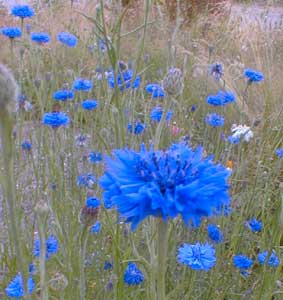 Right down to our own day, the bachelor button is associated with the Goddess Venus, & centaurea has remained a fixed feature of erotic or romantic lore. In folk belief, if a maiden wants to attract an eligible bachelor, she should keep a bachelor button secretly in an apron pocket, or between her bosoms. Or, a girl could assess the likelihood of a match by carrying a bachelor button somewhere on her person while thinking of the object of her interest. If the flower wilted prematurely, it was not a good match; if the flower was still fresh at the end of the day, she could expect the young man's attentions would lead to a good marriage. Bolder English girls would wear the flowers openly, to announce their own eagerness to wed.
Right down to our own day, the bachelor button is associated with the Goddess Venus, & centaurea has remained a fixed feature of erotic or romantic lore. In folk belief, if a maiden wants to attract an eligible bachelor, she should keep a bachelor button secretly in an apron pocket, or between her bosoms. Or, a girl could assess the likelihood of a match by carrying a bachelor button somewhere on her person while thinking of the object of her interest. If the flower wilted prematurely, it was not a good match; if the flower was still fresh at the end of the day, she could expect the young man's attentions would lead to a good marriage. Bolder English girls would wear the flowers openly, to announce their own eagerness to wed.Bachelor Buttons were also associated with men's virility, & they retain the name Centaurea because the centaurs had the sexual prowess of horses combined with the military knowledge of great generals. Cheiron, the centaur who was the fight instructor of many Greek heros & even of the god Apollo, fought in battle alongside Heracles, who accidentally wounded Cheiron with an arrow that had been dipped in the toxic blood of the Hydra. Cheiron cured his festering wounds by gathering bachelor buttons & plastering the flowers to his wounds. Belief in the healing capacity of bachelor button persists to this day.
Flora's month of May became the month of the Virgin Mary, whose sacred color was blue, so that any flower of this color was bound to have Mary myths attached. One of its folknames was "Mary's Crown" because of the flower's resemblance to a feathery cap. It was elsetimes said to have been Mary's cushion, upon which she rested her pretty feet.
There are now many colors of old-fashioned annual bachelor buttons available. The seeds we planted were the pure deep blue, but there were mixed in a few random pale blue, & a very few white ones with just hints of blue-frosted tips, one of these blooms shown in the third photo. The fourth photo shows a pale pink one.
But the original vibrant blue which gives it its species name remains the best. Of the perennial clumping centaureas, the best is Persian Bachelor Buttons. These have many invasively weedy cousins that should not be encouraged, collectively called knapweeds.